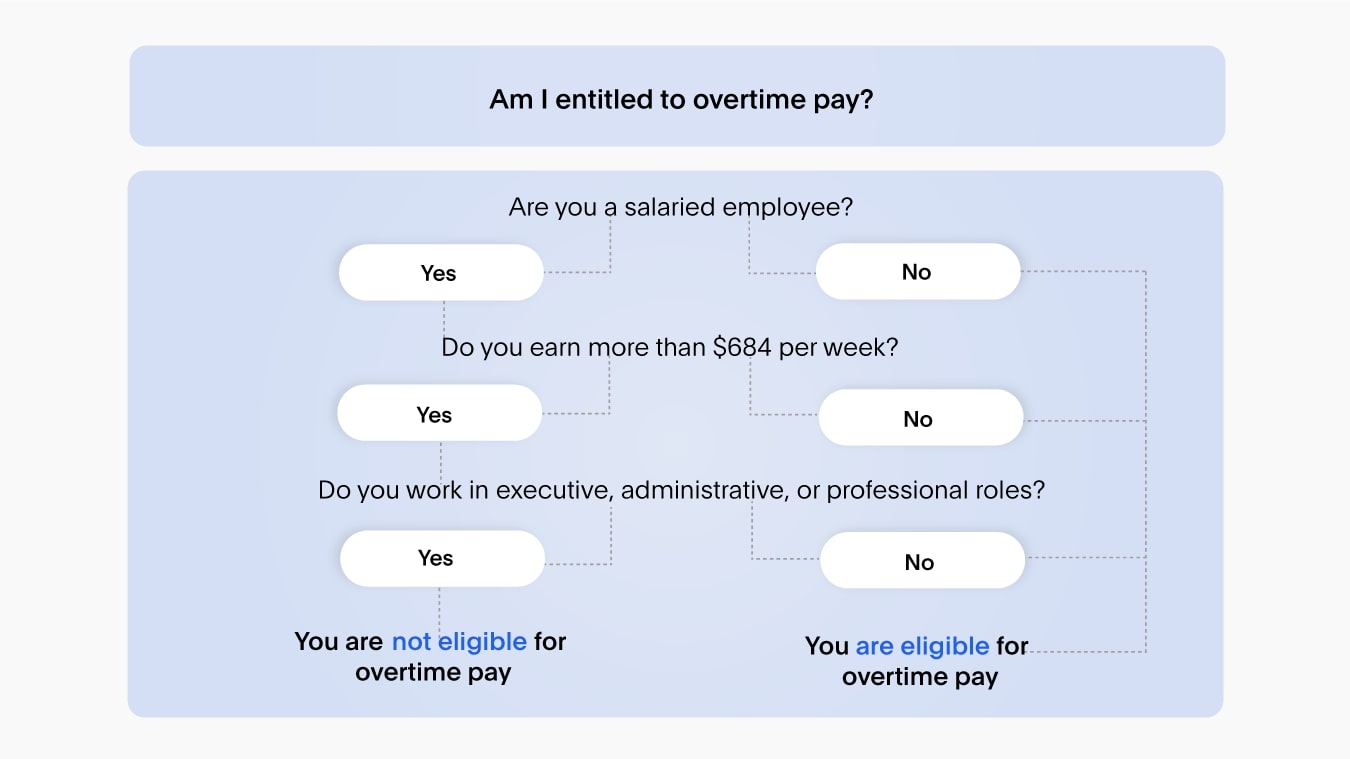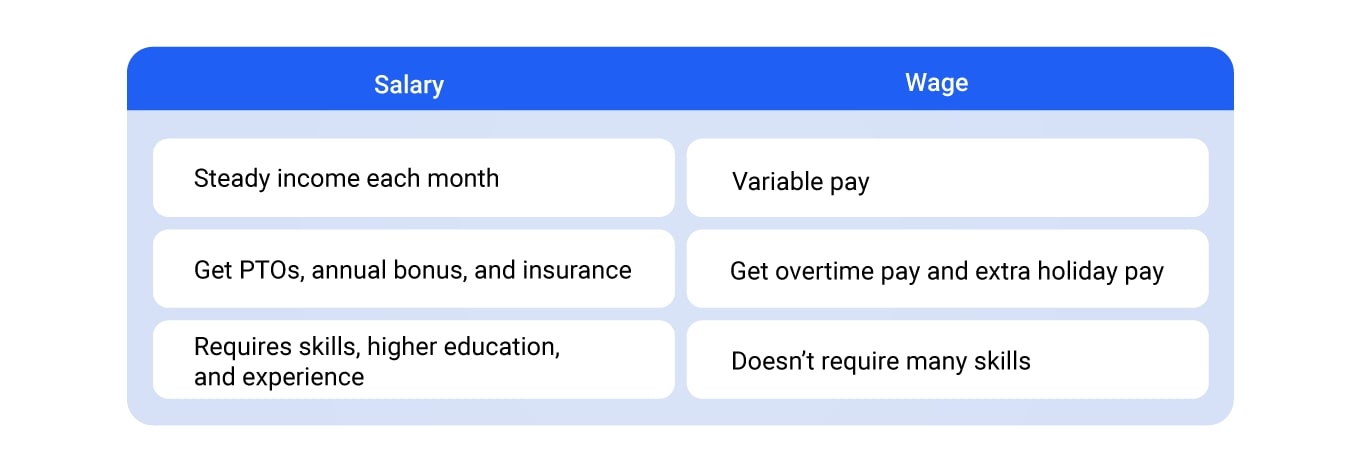Salary vs. Wage: What Are the Differences?

Many employers find difficulty in deciding whether to hire candidates for any particular role based on salary or wage. After all, how you compensate employees for any specific role can help you attract the right candidates in your organization.
Though some people use the terms salary and wage interchangeably, these hold different meanings.
Employees who work on an hourly basis get compensation in the form of wages. In contrast, professionals who apply their proficiency in their respective domains to help organizations generate revenue are paid salaries.
While this is a simple explanation, there’s a lot more that you need to understand to offer fair compensation as per prevalent laws and regulations.
So, this detailed guide will help you understand the key difference between wage and salary and what makes each compensation type suitable for certain work profiles.
What Is a Wage?
A wage is compensation that’s paid to employees based on the number of hours they take to complete any work that they have been assigned.
Here the employees are paid based on how many hours they work during each pay period (weekly, bi-weekly, semi-monthly, monthly) and their set pay rate.
Generally, wage workers are said to be doing blue-collar jobs. They’re unskilled or semi-skilled, do labor work, and usually work in the manufacturing industry.
|
The wage compensation per pay period is calculated based on how many hours an employee worked and the pay rate of the work. Employers are required to pay hourly workers as per the federal or state minimum wage rate. |
The wage is variable, as it can fluctuate from day to day based on individual performance and number of hours worked.
Besides, most wage workers fall in the category of non-exempt workers. Thus, FLSA rules are applied to them, including overtime pay. So, if any wage worker devotes extra hours at work, they’re entitled to overtime pay at one and a half rate. (We’ll discuss exempt and non-exempt employees in the next section).
Simply put, wage workers are paid for their working hours. They get overtime pay for devoting extra hours and aren’t paid for the time they don’t show up.
What Is a Salary?
Salary is a fixed annual compensation agreed upon between employer and employee. It’s paid on every predefined pay period, e.g., monthly/bi-weekly/semi-monthly.
In other words, a salary is a fixed amount of money that an employer pays its employees over a year at regular intervals.
Salaried people are said to be doing white-collar jobs and are the skilled resources who apply their proficiency in their respective fields.
|
Generally, the salary is disbursed on a monthly basis, so to know the amount an employee gets each month from the annual compensation/package, they can divide the total package by the total number of months, i.e., 12. |
Salary is an employee’s base pay and doesn’t include other benefits, such as commission, bonus, stipend, reimbursements, health insurance plans, etc. The salary amount gets incremented annually based on the employee’s performance.
Salaried employees are provided with paid time off and other such perks. This way, if they don’t show up at work on any day, they’re still paid the same amount on that pay period.
The number of work hours is fixed for salaried employees. However, if they devote extra hours at work, they aren’t entitled to overtime pay unless they fall into a non-exempt employee category.
Simply put, salaried employees get the same payment on each pay period, irrespective of hours and days worked. However, they don’t get overtime pay for working extra hours unless they’re non-exempt employees.
Examples of Wage and Salary Calculation
Wage Example: Suppose an electrician is hired at the rate of $10 per hour and gets a wage every week. The wage to be paid each week can be calculated by multiplying the total hours worked in a week by the pay rate.
Suppose he works 40 hours a week, then the total wage he should receive during the pay period (each week) will be-
40 x $10 = $400
Salary Example: Suppose an administrative manager has been hired at a salary of $240,000 per year. Now, the company processes an employee’s payroll on a monthly basis. In that case, the salary they get each month can be calculated by dividing the total package by the number of months, that is, 12.
$240,000 / 12 = $20,000
|
Usually, a salary is something in which the employee draws the same amount every pay period irrespective of the extra or fewer hours they put in. On the other hand, a wage is disbursed as per the hourly pay rate and how many hours an employee puts in during the pay period. |
As mentioned earlier, wage workers are eligible for overtime pay for working extra hours. Salaried workers can get it too but only if they fall in the non-exempt worker category.
But who are the non-exempt workers?
Know the difference between exempt and non-exempt workers in the next section.
Exempt and Non-Exempt Employees
Non-Exempt Employees
According to Fair Labor Standards Act, non-exempt workers are employees who:
- usually do physical labor and repetitive work
- get overtime pay at the rate of time and a half if they work beyond 40 hours
FLSA’s minimum salary threshold changes from time to time. Currently, it’s $684 per week, i.e., employees must earn less than $684 per week to be classified as non-exempt.
Some examples of non-exempt workers are carpenters, electricians, artisans, welders, and manual laborers.
To understand the concept of overtime pay, suppose an hourly worker who’s a non-exempt employee works at the pay rate of $10. Now on a certain week, she works 44 hours a week, which is four hours beyond the standard hours.
So, the employer needs to pay her $400 for the first 40 hours. For the rest of the 4 hours, she must be paid $60 at the rate of 1.5, which becomes $15 per hour.
Thus, her total earning for that week becomes $400 + $60 = $460.
Exempt Employees
As defined by Fair Labor Standards Act, exempt employees are the ones who are:
- paid more than $684 per week
- skilled and knowledgeable employees who work in executive, administrative, professional, and outside sales roles (certain computer professionals are also exempt employees)
- not eligible for overtime pay even if they work beyond 40 hours
Workers who fulfill these criteria are exempt employees, which means they get exempted from FLSA rules; thus, overtime pay doesn’t apply to them.
CEO, managers, licensed engineers, human resources, software engineers, and lawyers fall under the exempt employees category.
|
Bookmark For Further Reading Want to understand in depth about this classification for proper pay disbursement? Then check out our quick guide on this topic: Exempt vs. Non-Exempt Employees: Simplify Employee Classification |
Concept of Exemption For Salary and Wage Workers
Most hourly wage workers come in the category of non-exempt employees, and they’re eligible for overtime pay for work done beyond 40 hours.
On the other hand, most salaried workers fall in the category of exempt employees. Thus, they’re not entitled to overtime pay even if they work overtime.
What about salaried employee’s who are paid less than $684 per week?
They’ll fall into the non-exempt employees category and be eligible for overtime pay for additional hours worked beyond 40.

|
In short, If the employee is salaried and classified as an exempt worker, they aren’t eligible for overtime pay. On the other hand, if the employee is salaried but classified as a non-exempt employee, they’re entitled to overtime pay. |
What Kind of Job Roles Work Well With Salary vs. Wage?
Workers Who Earn a Wage
People who work as part-time, gig workers or seasonal staff get compensation in the form of wages. Such wage workers are semi-skilled or unskilled and are supervised by managers. Restaurant workers, electricians, carpenters, mechanics, and laborers in construction sites are usually paid hourly and thus earn a wage.
Workers Who Earn a Salary
Full-time employees who are hired for a skilled role can be compensated with a salary. The job roles can vary widely, ranging from chartered accountants, financial advisors, engineers, software developers, HR professionals, business development executives, market research analysts etc.
Advantages and Disadvantages of Salary and Wage

Pros of Salary
For Employees
-
Stable and Consistent Payment
Unlike wage workers, whose pay may fluctuate depending on the number of hours worked, salary workers get consistent and fixed salaries as per their pay period.
Despite how many hours they work each day, they still get the same compensation for their pay period.
Salaried employees are well aware of how much they’ll earn each month, which helps them plan their monthly budget accordingly.
-
Paid Time Off and Other Perks
People who get a salary may also receive other perks, such as paid time off (PTOs), bonuses, allowance, insurance, etc.
Thus, salaried employees can take leave whenever needed without experiencing any paycheck deductions.
In addition, employers can also offer other benefits to their salaried employees, such as flexible work timings, alternative work schedules, and remote working, which gives them better work-life balance and flexibility to work.

For Employers
-
Helps Attract Skilled and Experienced Candidates
Most of the employees prefer stable and consistent pay in the form of a salary, which gives them a sense of security. Thus, providing a fixed salary helps employers attract skilled, talented and senior employees in their organization.
-
Not Crucial to Track Employee’s Time
When the employer provides fixed salaries to employees, tracking their work hours isn’t mandatory, unless the employers want to track their time on purpose to check whether or not they’re devoting the required hours at the workplace. This is especially true for remote and hybrid workers.
-
No Need to Pay For Overtime Work
If the employees work overtime to complete any urgent deliverables on time, employers wouldn’t have to compensate them with overtime pay for working beyond the usual hours unless they’re non-exempt employees.
Cons of Salary
For Employees
-
No Overtime Pay
One of the major drawbacks of salaried workers is that overtime pay isn’t available for working beyond 40 hours unless they’re non-exempt employees.
Whether they work on a weekend or holiday or exceed 40 hours, they won’t be entitled to overtime pay.
Although employees get full compensation for working fewer hours on a few days, they’re also not provided with any overtime pay for working extra hours.
-
Fluctuation in Performance-Based Bonus
Most salaried employees get their bonuses and increments based on the KRA (Key Result Area) sheet that shows the performance metrics of individual employees.
Thus, if an employee can’t meet the benchmark of the expected performance, they may either lose the bonus or get a lesser amount.
-
Need to Be Available During the Off-Work Hours
Some salaried jobs require employees to attend office calls or show up in an emergency during their off-hours.
For example, if you’re a doctor, you may have to address emergency cases during your off-hours, provided the substitute doctor isn’t available.
Additionally, if the senior employee or a manager is on leave, they may still have to attend important office calls to keep the workflow going.
For Employers
-
Paying the Same Amount Every Month
If an employee works fewer hours than expected on some days, employers still need to pay them the same amount of salary each pay period.
For example, during any slow week, if an employee works only four to five hours a day, they’ll still be paid the same amount of salary without any deduction in their monthly paycheck.
-
Dissatisfied Employees for Not Getting Overtime Pay
Suppose the employees are required to work overtime frequently to stay on top of their deliverables or complete any project before the deadline. In that case, they’ll likely be dissatisfied with this culture of not getting overtime pay for working additional hours.
Advantages and Disadvantages of Salary: A Snapshot
| Advantages of Salary | Disadvantages of Salary |
| From Employee’s Perspective | From Employee’s Perspective |
| Employees get stable and consistent pay to budget accordingly | No overtime pay unless they are non-exempt employees |
| Perks such as paid time offs, insurance, etc. are available | Need to be available during non-work hours to address any emergency case or important meeting |
| Bonus and commissions available over the salary amount | Fluctuation in bonus amount depends upon the KRA |
| From Employer’s Perspective | From Employer’s Perspective |
| No need to pay employees for working extra hours | Need to pay same fixed salary irrespective of employee’s work hours |
| Easier to attract talented and skilled candidates to an organization. | Employees can be dissatisfied over not getting overtime pay for working additional hours |
Pros of Wage
For Employee
-
Lesser Work Responsibilities
Mostly, companies hire hourly workers as they require unskilled or semi-skilled workers who can do repetitive or labor work.
Thus, hourly workers don’t have a lot of responsibilities like salaried employees. They usually work on one type of task most of the time and don’t have to multitask or do context-switching.
-
No Contracts or Bond
Salaried employees are usually contracted to stay in a company for a stipulated time period. However, hourly workers don’t have a contract that requires them to work for an employer for any duration. They can switch to another job if offered a wage with a better pay rate or if they have any other issue with their current employment.

-
Getting Overtime Pay
Hourly, non-exempt workers are entitled to overtime pay if they work additional hours beyond their contracted hours.
Thus, if the wage workers need to earn more, they can work beyond 40 hours, and get paid at the rate of one and a half for those extra hours.
-
Flexibility to Work Part Time
Wage work culture is beneficial for those employees who don’t want to do 9 to 5 job and can devote only fewer hours as part-time workers.
In addition, people who want to take on two jobs simultaneously to earn more money also find the wage work culture useful.
-
Simple Transactions and Easy-to-Understand Calculations
This advantage is common for employees and employers because the wage calculation is easy to understand.
The wage calculation doesn’t involve any kind of bonus, allowance, deductions, or other benefits that may be hard to calculate and process.
It merely requires the total work hours in a stipulated pay period (e.g., week) to be multiplied by the pay rate. This calculation provides the wage for a week.
For Employer
-
Paying for the True Work
The earnings of a wage worker are reflected in their work hours, that is, employers pay their employees for the hours in which they worked productively. This is unlike salaried employees, where employers still have to provide full compensation if they work fewer hours during slow week periods.
-
No Contracts
Employers can review the performance of wage workers periodically to see if they’re delivering up to the mark.
If employers aren’t satisfied with the output, they can either reduce the pay rate or replace the current worker with another one without worrying about any fixed contractual obligations in most cases.
-
Easy Workforce and Workload Management
Wage form of compensation allows employers to adjust their workforce based on their business’s needs.
For instance, they can hire more workers during busy seasons and fewer during slow periods.
It can also work the other way around, i.e., employers can ask employees to work more hours during peak season and fewer hours during general days.
Besides, employers who need additional workforce during the busy period can hire some seasonal workers on an hourly basis to accommodate the extra workload.
Cons of Wage
For Employees
-
Benefits and PTOs Not Available
Wage workers aren’t offered any paid time off or other such benefits that salaried employees get.
If these employees don’t show up on any day, they won’t be paid for that day, and if they work fewer hours, they’ll be paid only for those hours.
Besides, they’re also not provided with insurance, bonus, reimbursement, or retirement plans.
-
Fluctuating Payment
If an employee is not getting enough hours to work or works fewer hours on some days, it will reflect on their wage. Thus, the wage can vary significantly based on hours worked, due to which employees find it difficult to plan their budget in advance.
For Employers
-
Tracking Hours Using a Manual Timesheet
To calculate the wage, employers must keep track of employees’ work hours. Therefore, they’re required to use timesheets or other time-tracking systems, such as spreadsheets. However, the systems with manual tracking are prone to errors, miscalculations, and buddy punching.
Their erroneous data can cost a great deal of money to the employers. In fact, a survey from Ernst & Young (EY) reveals that fixing a single payroll mistake costs around $291 to the company.
As a solution, employers can choose to invest in any efficient time-tracking software, such as Replicon, that can automatically capture work data with 100% accuracy.
Advantages and Disadvantages of Wage: A Snapshot
| Advantages of Wage | Disadvantages of Wage |
| From Employee’s Perspective | From Employee’s Perspective |
| There are no contracts or bonds | There are no benefits such as PTOs, insurance, or retirement plans |
| Wage workers have fewer work responsibilities | Payment can vary based on the number of hours worked or pay rate variation. This prevents proper budget planning |
| Overtime pay available for working additional hours | |
| There’s flexibility to work part-time | |
| Wage calculation is easy to understand for employees and employers | |
| From Employer’s Perspective | From Employer’s Perspective |
| Having no contracts helps employers hire suitable workers as required without worrying about fixed contracts | To calculate wage, employers need to use a timesheet that’s prone to errors due to manual time entry |
| Employers can pay their employees for the actual work done | |
| Employers can adjust the workforce from season to season |
Difference Between Salary and Wage
To know the key differences between salary and wage, including the available benefits for both types of workers who are compensated as per these, refer to the table below.
| Salary | Wage |
| Provided to skilled employees who hold expertise in any domain and use it to generate revenue for the organization | Provided to employees who are usually unskilled or semi-skilled and work on an hourly basis as non-exempt employees. |
| It’s an annual fixed amount of money agreed upon between employer and employee Employers disburse this amount over a year on a fixed pay period | Wage is a variable pay that an employer pays based on the number of hours worked and the pay rate set |
| Salary remains fixed until increments after a year based on the performance review | Wage can fluctuate as per the employee’s work hours. |
| Generally, credited for a pay period, mostly on a monthly basis. | Calculated on a daily basis based on the number of hours worked. However, employers can choose to pay on a weekly/bi-weekly/monthly basis. |
| People who draw a salary are mostly full-time workers | People who draw wages are mostly part-time workers. |
| Salary workers are skilled professionals who work in executive or administrative roles, such as CA, financial advisors, software developers, HR, etc. | Wage workers are unskilled or semi-skilled and work as electricians, carpenters, mechanics, etc. |
| Salary workers have a contract to work with that company for a stipulated period. | Wage workers don’t have any contracts. |
| Salaried employees (exempt) don’t get overtime pay for working extra hours beyond the contracted hours. | Wage workers get overtime pay for working extra hours above 40 hours at the rate of one and a half. |
| Salaried employees get PTOs, insurance, retirement plans, and other benefits. | Wage workers don’t get any PTOs and other benefits. |
| Salaried workers are assessed periodically using KRA, through which their performance is judged and receive a bonus. | The performance of wage workers is evaluated according to the time taken to complete any work. |
Salary vs. Hourly Wage: What’s the Best Compensation Method?
Organizations need a workforce for different roles and responsibilities. Thus, employers can hire people with salary basis compensation if they want to onboard full-time employees for a long period. Otherwise, they can hire people on a wage basis compensation if they need part-time employees for some unskilled work.
In fact, they can also go for a mix of both employee types, i.e., some salaried employees for skilled work and others wage workers for unskilled work.
Hiring people with a salary helps attract skilled and senior workers who expect a stable payment. The steady employee paycheck also stabilizes payroll, as costs will remain predictable and the same.
On the other hand, wage workers help cut costs whenever required as per the season.
You can hire wage workers whenever needed without any contract and pay them only for the actual hours worked. Thus, it becomes easy to adjust your company costs during slow weeks.
|
To determine whether you should hire employees with salary or wage, assess these factors-
|
The type of compensation greatly depends on the kind of work you require. For example, if you need to complete work that doesn’t require significant skills, then wage-based payment can work well.
On the other hand, if you have a project for which you’ll need knowledge workforce to apply their expertise in a specific domain, hiring people with a salary will be the right thing to do.
After assessing the above pointers and keeping the pros and cons of salary and wage in mind, you can make a call on what type of compensation you should provide to your employees.
Bottom Line
Whether you hire employees with wage or salary basis compensation, always check different parameters that can impact your payroll processing, costing, and company’s goal. To get a better idea, evaluate what type of workforce you need to complete the work and how other employers in the market and industry are hiring for those roles.






